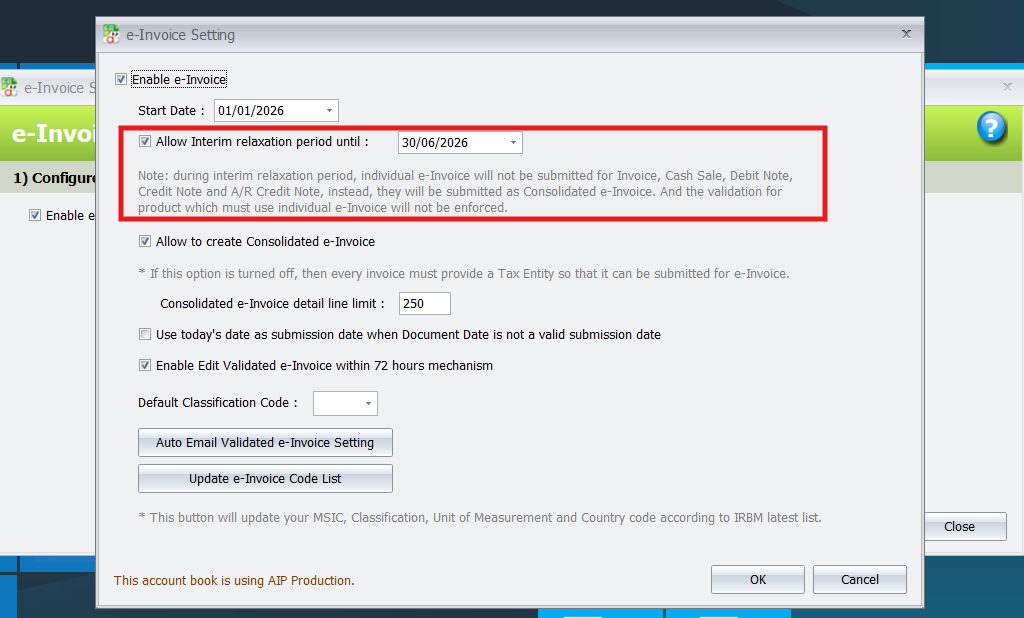-
AutoCount Accounting Features
-
- Approval Workflow
- Audit Trail
- Auto Save in Draft Folder
- AutoCount Contra Account
- AutoCount License Setting Guide
- Deposit Tracking & Management
- Documents Running Number
- Full Transfer and Partial Transfer
- Import Data to AutoCount Accounting Using Excel
- Informative Charts and Analytical Data
- Layout Customization
- Multi Pricing
- Sales and Services Tax
- Schedule Backup
- Search Lookup Edit
- View Documents Flow
- Show Remaining (1) Collapse
-
AutoCount Cloud Accounting
-
AutoCount E-Invoice
-
AutoCount HRMS User Guide
-
-
- Coming soon
-
- Coming soon
-
- Coming soon
-
- Coming soon
-
-
AutoCount Modules
-
- Activity Stream
- Advanced Financial Report
- Advanced Item
- Advanced Multi-UOM
- Advanced Quotation Module
- Basic Multi-UOM
- Budget Module
- Consignment
- Filter By Salesman
- FOC Quantity
- Formula
- Item Batch
- Item Package
- Landing Cost
- Multi-Currency
- Multi-Dimensional Analysis
- Multi-Location
- Project Account
- Recurrence
- Remote Credit Control Module
- Stock Assembly
- User Defined Fields (UDF)
- Show Remaining (7) Collapse
-
AutoCount Plugins
-
Form Template
-
Report Template
-
- Advance Quotation
- Cash Sale
- Consignment
- Consignment Movement
- Credit Note
- Debit Note
- Delivery Order
- FOC Quantity Analysis By Document Report
- Invoice
- Item Package Sales Report
- Monthly Sales Analysis
- Outstanding Sales Order Listing
- Profit And Loss Of Documents
- Quotation
- Sales Agent Contribution Report
- Sales Order
- Top/Bottom Sales Ranking
- Show Remaining (2) Collapse
-
- Available Stock Status Report
- Expired Item Batch Listing
- Inventory Physical Worksheet
- Stock Adjustment
- Stock Aging Report
- Stock Assembly
- Stock Assembly Order
- Stock Balance By Location
- Stock Balance Report
- Stock Card Report
- Stock Disassembly
- Stock Issue
- Stock Item Profit Margin
- Stock Movement Report
- Stock Receive
- Stock Take
- Stock Transfer
- Stock Write Off
- Show Remaining (3) Collapse
AutoCount E-invoice:
How to Handle Interim Relaxation Period?
Understanding Interim Relaxation Period
The Interim Relaxation Period temporarily relieves businesses from stringent e-invoice submission requirements, enabling a smoother transition to full compliance. For those looking to handle interim relaxation period in AutoCount, this phase provides opportunities to streamline operations and manage e-invoice transactions efficiently. This guide focuses on how AutoCount handles e-invoicing during this period.
AutoCount E-Invoice Interim Relaxation Period
This video explains the Interim Relaxation Period for standard, consolidated, and self-billed e-invoices, providing clarity on compliance requirements and transitional provisions during this phase.
Key Features of the Interim Relaxation Period
- Standard invoices, cash sales, credit notes, debit notes, and other transactions are merged into a single consolidated e-invoice.
- As a result, businesses can save time by avoiding the need for individual standard invoice submissions.
- Individual standard invoice submissions are not required.
- The IRBM will not prosecute non-compliance if consolidated invoices are submitted within 7 days after month-end.
- In addition to the relaxed compliance standards, businesses can also optionally share validated invoices with buyers.
- Businesses can optionally share validated invoices with buyers.
How AutoCount Handles E-Invoice Transactions During the Interim Period?
Enable Interim Relaxation period
- Open AutoCount Accounting (version 2.2.22.30 or newer recommended).
- Navigate to e-Invoice tab > e-Invoice Setting.

- Tick Enable e-Invoice.
- Tick Allow Interim relaxation period until: > Click OK
💡 Note: AutoCount will automatically assigned the interim relaxation period based on your start date which is 6 months.

Managing E-Invoices in AutoCount During the Interim Period

Key Benefits of Using AutoCount During the Interim Period
Conclusion
AutoCount equips businesses with tools to navigate the Interim Relaxation Period seamlessly. By automating e-invoice consolidation, disabling unnecessary submissions, and ensuring compliance with IRBM guidelines, AutoCount simplifies the transition to full e-invoicing. Leverage these features to stay ahead and compliant during this crucial phase. Ultimately, AutoCount’s robust tools ensure that businesses can navigate the Interim Relaxation Period with ease and confidence.
FAQs
AutoCount combines multiple transaction types (e.g., cash sales, credit notes) into a single consolidated e-invoice.
Non-compliance during the interim period is not penalized, provided consolidated invoices are eventually submitted.
Yes, AutoCount’s bulk processing tools are designed for high transaction volumes.
Consolidated invoices must be submitted via the IRBM portal within 7 days after month-end.
While AutoCount automates much of the process, a final manual review ensures accuracy.
Once the interim period ends, businesses must fully comply with e-invoice submission standards.
